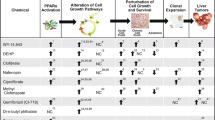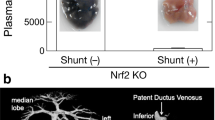Abstract
Cultivated hepatocytes represent a well-established in vitro system. However, the applicability of hepatocytes in toxicogenomics is still controversially discussed. Recently, an in vivo/in vitro discrepancy has been described, whereby the non-genotoxic rat liver carcinogen methapyrilene alters the expression of the metabolizing genes SULT1A1 and ABAT, as well as the DNA damage response gene GADD34 in vitro, but not in vivo. If the collagen sandwich cultures of hepatocytes really produce false-positive data, this would compromise its application in toxicogenomics. To revisit the putative in vivo/in vitro discrepancy, we first analyzed and modeled methapyrilene concentrations in the portal vein of rats. The relatively short half-life of 2.8 h implies a rapid decrease in orally administered methapyrilene in vivo below concentrations that can cause gene expression alterations. This corresponded to the time-dependent alteration levels of GADD34, ABAT and SULT1A1 RNA in the liver: RNA levels are altered 1, 6 and 12 h after methapyrilene administration, but return to control levels after 24 and 72 h. In contrast, methapyrilene concentrations in the culture medium supernatant of primary rat hepatocyte cultures decreased slowly. This explains why GADD34, ABAT and SULT1A1 were still deregulated after 24 h exposure in vitro, but not in vivo. It should also be considered that the earliest analyzed time point in the previous in vivo studies was 24 h after methapyrilene administration. In conclusion, previously observed in vitro/in vivo discrepancy can be explained by different pharmacokinetics present in vitro and in vivo. When the in vivo half-life is short, levels of some initially altered genes may have returned to control levels already 24 h after administration.




Similar content being viewed by others
Abbreviations
- SULT1A1:
-
Sulfotransferase
- ABAT:
-
4-aminobutyrate aminotransferase
- GADD34:
-
Growth arrest and DNA damage inducible gene 34
- ABCB1:
-
Multi drug resistance protein 1NQO1: NADPH-quinone oxidoreductase
References
Bauer A, Schumann A, Gilbert M, Wilhelm C, Hengstler JG, Schiller J, Fuchs B (2009) Evaluation of carbon tetrachloride-induced stress on rat hepatocytes by 31P NMR and MALDI-TOF mass spectrometry: lysophosphatidylcholine generation from unsaturated phosphatidylcholines. Chem Phys Lipids 159(1):21–29
Beekmann JM, Boess F, Hildebrand H, Kalkuhl A, Suter L (2006) Gene Expression analysis of the hepatotoxicant methapyrilene in primary rat hepatocytes: an interlaboratory study. Environ Health Perspect 114(1):92–99
Boess F, Kamber M, Romer S, Gasser R, Muller D, Albertini S, Suter L (2003) Gene expression in two hepatic cell lines, cultured primary hepatocytes, and liver slices compared to the in vivo liver gene expression in rats: possible implications for toxicogenomics use of in vitro systems. Toxicol Sci 73(2):386–402
Brown RP, Delp MD, Lindstedt SL, Rhomberg LR, Beliles RP (1997) Physiological parameter values for physiologically based pharmacokinetic models. Toxicol Ind Health 13:407–484
Calandre EP, Alferez N, Hassanein K, Azarnoff DL (1981) Methapyrilene kinetics and dynamics. Clin Pharmacol Ther 29:527–532
Doktorova TY, Ellinger-Ziegelbauer H, Vinken M, Vanhaecke T, Delft J, Kleinjans J, Ahr HJ, Rogiers V (2012) Comparison of hepatocarcinogen-induced gene expression profiles in conventional primary rat hepatocytes with in vivo rat liver. Arch Toxicol 86(9):1399–1411
Ellinger-Ziegelbauer H, Stuart B, Wahle B, Bomann W, Ahr HJ (2005) Comparison of the expression profiles induced by genotoxic and nongenotoxic carcinogens in rat liver. Mutat Res 575(1–2):61–84
Ellinger-Ziegelbauer H, Gmuender H, Bandenburg A, Ahr HJ (2008) Prediction of a carcinogenic potential of rat hepatocarcinogens using toxicogenomics analysis of short-term in vivo studies. Mutat Res 637:23–39
Fielden MR, Brennan R, Gollub J (2007) A gene expression biomarker provides early prediction and mechanistic assessment of hepatic tumor induction by nongenotoxic chemicals. Toxicol Sci 99:90–100
Godoy P, Hengstler JG, Ilkavets I, Meyer C, Bachmann A, Müller A, Tuschl G, Mueller SO, Dooley S (2009) Extracellular matrix modulates sensitivity of hepatocytes to fibroblastoid dedifferentiation and transforming growth factor beta-induced apoptosis. Hepatology 49(6):2031–2043
Godoy P, Schug M, Bauer A, Hengstler JG (2010a) Reversible manipulation of apoptosis sensitivity in cultured hepatocytes by matrix-mediated manipulation of signaling activities. Methods Mol Biol 640:139–155
Godoy P, Lakkapamu S, Schug M, Bauer A, Stewart JD, Bedawi E, Hammad S, Amin J, Marchan R, Schormann W, Maccoux L, von Recklinghausen I, Reif R, Hengstler JG (2010b) Dexamethasone-dependent versus -independent markers of epithelial to mesenchymal transition in primary hepatocytes. Biol Chem 391(1):73–83
Heise T, Schug M, Storm D, Ellinger-Ziegelbauer H, Ahr HJ, Hellwig B, Rahnenfuhrer J, Ghallab A, Guenther G, Sisnaiske J, Reif R, Godoy P, Mielke H, Gundert-Remy U, Lampen A, Oberemm A, Hengstler JG (2012) In vitro–in vivo correlation of gene expression alterations induced by liver carcinogens. Curr Med Chem 19(11):1721–1730
Hengstler JG, Utesch D, Steinberg P, Platt KL, Diener B, Ringel M, Swales N, Fischer T, Biefang K, Gerl M, Böttger T, Oesch F (2000) Cryopreserved primary hepatocytes as a constantly available in vitro model for the evaluation of human and animal drug metabolism and enzyme induction. Drug Metab Rev 32:81–118
Hewitt NJ, Lechón MJG, Houston JB, Hallifax D, Brown HS, Maurel P, Kenna JG, Gustavsson L, Lohmann C, Skonberg C, Guillouzo A, Tuschl G, Li AP, LeCluyse E, Groothuis GMM, Hengstler JG (2007) Primary hepatocytes: current understanding of the regulation of metabolic enzymes and transporter proteins, and pharmaceutical practice for the use of hepatocytes in metabolism, enzyme induction, transporter, clearance, and hepatotoxicity studies. Drug Metab Rev 39:159–234
Hrach J, Mueller SO, Hewitt P (2011) Development of an in vitro liver toxicity prediction model based on longer term primary rat hepatocyte culture. Toxicol Lett 206(2):189–196
Kelly DW, Holder CL, Korfmacher WA, Slikker W (1990) Plasma elimination and urinary excretion of methapyrilene in the rat. Drug Metab Dispos 18:1018–1024
Kienhuis AS, van de Poll MCG, Wortelboer H, van Herwijnen M, Gottschalk R, Dejong CHC, Boorsma A, Paules RS, Kleinjans JCS, Stierum RH, van Delft JHM (2009) Parallelogram approach using rat-human in vitro and rat in vivo toxicogenomics predicts acetaminophen-induced hepatotoxicity in humans. Toxicol Sci 107(2):544–552
Knobeloch D, Ehnert S, Schyschka L, Büchler P, Schoenberg M, Kleef J, Thasler WE, Nussler NC, Godoy P, Hengstler J, Nussler AK (2012) Human hepatocytes: isolation, culture and quality procedures. Methods Mol Biol 806:99–120
Mathijs K, Brauers KJJ, Jennen DGJ, Boorsma A, van Herwijnen MHM, Gottschalk RWH, Kleinjans JCS, van Delft JHM (2009) Discrimination for genotoxic and nongenotoxic carcinogens by gene expression profiling in primary mouse hepatocytes improves with exposure time. Toxicol Sci 112(2):374–384
Mathijs K, Brauers KJ, Jennen DG, Lizarraga D, Kleinjans JC, van Delft JH (2010) Gene expression profiling in primary mouse hepatocytes discriminates true from false-positive genotoxic compounds. Mutagenesis 25(6):561–568
Mielke H, Anger LT, Schug M, Hengstler JG, Stahlmann R, Gundert-Remy U (2010) A physiologically based toxicokinetic modelling approach to predict relevant concentrations for in vitro testing. Arch Toxicol 85:555–563
Pelkonen O, Kapitulnik J, Gundert-Remy U, Boobis AR, Stockis A (2008) Local kinetics and dynamics of xenobiotics. Crit Rev Toxicol 38(8):697–720
Schmitt W (2008) General approach for the calculation of tissue to plasma partition coefficient. Toxicol In Vitro 22:457–467
Schug M, Heise T, Bauer A, Storm D, Blaszkewicz M, Bedawy E, Brulport M, Geppert B, Hermes M, Föllmann W, Rapp K, Maccoux L, Schormann W, Appel KE, Oberemm A, Gundert-Remy U, Hengstler JG (2008) Primary rat hepatocytes as in vitro system for gene expression studies: comparison of sandwich, Matrigel and 2D cultures. Arch Toxicol 82(12):923–931
Uehara T, Minowa Y, Morikawa Y, Kondo C, Maruyama T, Kato I, Nakatsu N, Igarashi Y, Ono A, Hayashi H, Mitsumori K, Yamada H, Ohno Y, Urushidani T (2011) Prediction model of potential hepatocarcinogenicity of rat hepatocarcinogens using a large-scale toxicogenomics database. Toxicol Appl Pharmacol 255:297–306
Ullrich A, Stolz DB, Ellis EC, Strom SC, Michalopoulos GK, Hengstler JG, Runge D (2009) Long term cultures of primary human hepatocytes as an alternative to drug testing in animals. ALTEX 26(4):295–302
Van Kesteren PC, Zwart PE, Pennings JL, Gottschalk WH, Kleinjans JC, van Delft JH, van Steeg H, Luijten M (2011) Deregulation of cancer-related pathways in primary hepatocytes derived from DNA repair-deficient Xpa-/-p53 ± mice upon exposure to benzo[a]pyrene. Toxicol Sci 123(1):123–132
Vinken M, Decrock E, Doktorova T, Ramboer E, De Vuyst E, Vanhaecke T, Leybaert L, Rogiers V (2011) Characterization of spontanous cell death in monolayer cultures of primary hepatocytes. Arch Toxicol 85(12):1589–1596
Zellmer S, Schmidt-Heck W, Godoy P, Wenig H, Meyer C, Lehmann T, Sparna T, Schormann W, Hammad S, Kreutz C, Timmer J, von Weizsäcker F, Thürmann PA, Merfort I, Guthke R, Dooley S, Hengstler JG, Gebhardt R (2010) Transcription factors ETF, E2F, and SP-1 are involved in cytokine-independent proliferation of murine hepatocytes. Hepatology 52:2127–2136
Acknowledgments
This study was supported by the SEURAT-1 projects NOTOX (EU-Project FP 7-Health- Grant Agreement No. 267038) and DETECTIVE (EU-Project FP 7-Health-Grant Agreement No. 266838) and by the Federal Ministry of Education and Research (BMBF; Förderkennzeichen 0313854).
Conflict of interest
The authors declare that they have no conflict of interest.
Author information
Authors and Affiliations
Corresponding author
Additional information
Markus Schug, Regina Stöber and Tanja Heise contributed equally to this work.
Rights and permissions
About this article
Cite this article
Schug, M., Stöber, R., Heise, T. et al. Pharmacokinetics explain in vivo/in vitro discrepancies of carcinogen-induced gene expression alterations in rat liver and cultivated hepatocytes. Arch Toxicol 87, 337–345 (2013). https://doi.org/10.1007/s00204-012-0999-8
Received:
Accepted:
Published:
Issue Date:
DOI: https://doi.org/10.1007/s00204-012-0999-8




